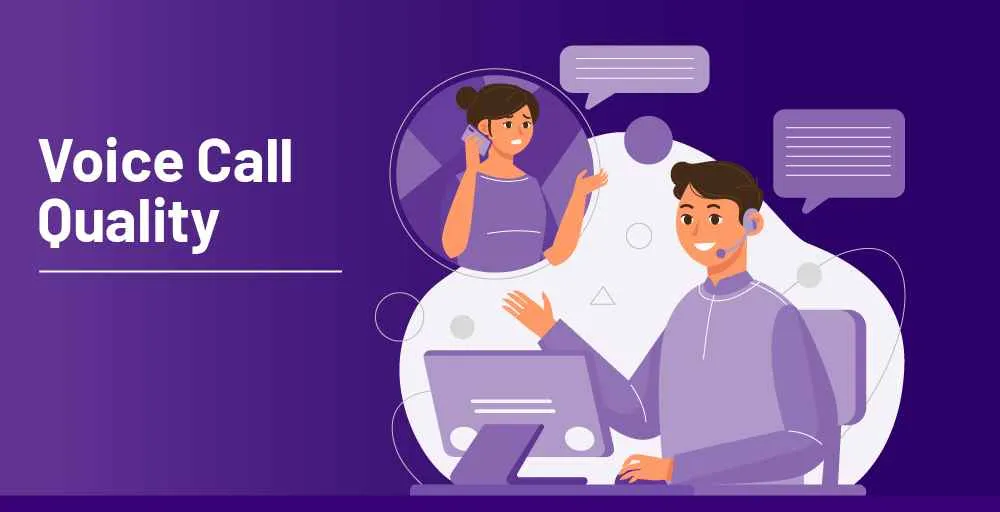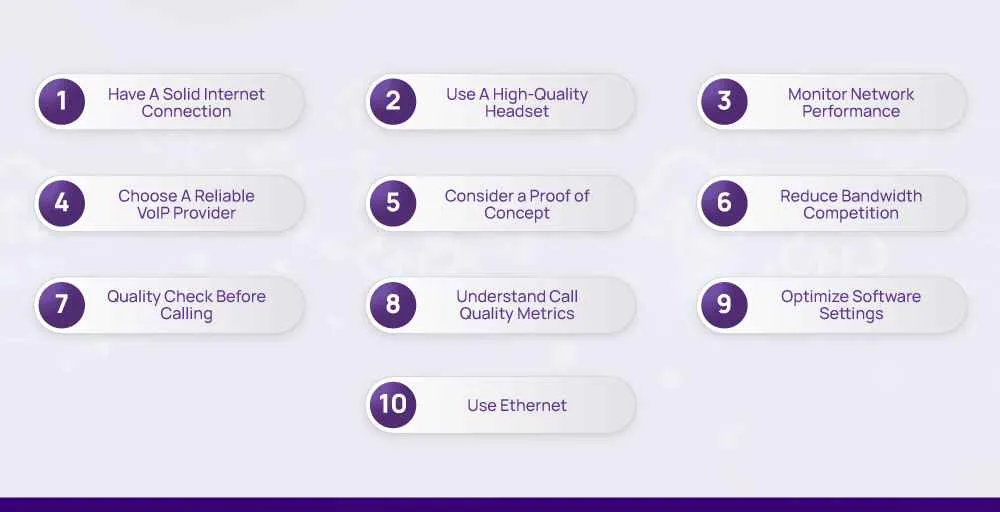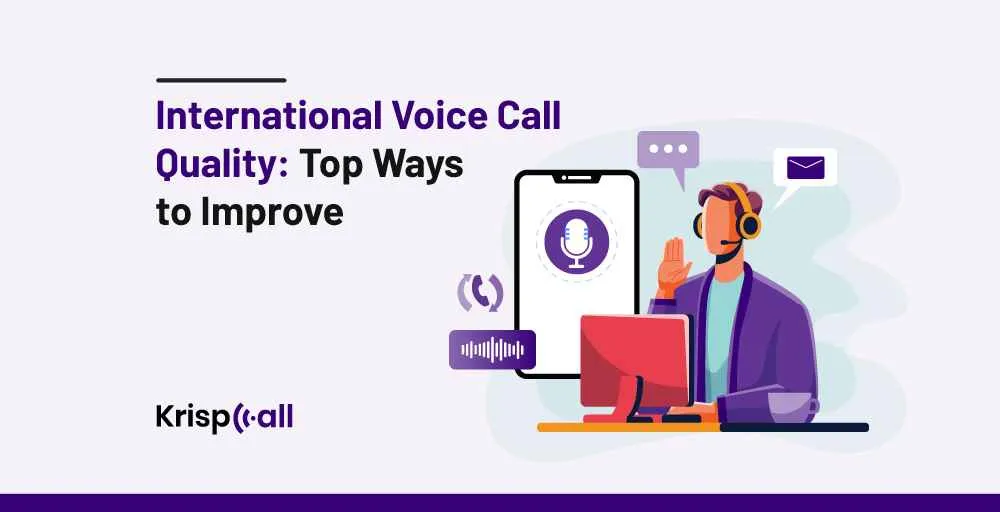International communication is essential for businesses of all sizes. Reliable international voice call quality is essential when making frequent international calls, whether for collaboration or customer service across different countries.🌍
However, ensuring crystal-clear communication across all aspects comes with its own set of challenges. While you might have the best VoIP technology on your side, having the best international voice call quality requires a lot more than just that.
With this guide, we’ll cover international call quality, its common challenges, and how you can improve voice call quality.💫
👓KEY HIGHLIGHTS
- Voice call quality refers to the quality of voice conversations.
- Factors like latency, jitter, packet loss, poor network, routing issues, and internet traffic congestion are common challenges in international voice call quality.
- A good internet connection, using a high-quality headset, considering PoC, quality checking, and using ethernet can help improve internal voice call quality.
- KrispCall provides the best international call quality for global calling.
What is a voice call quality?
Voice call quality refers to voice communication quality. It means how well you can hear the other person on a call carried out through a VoIP telephony platform. Voice call quality is one of the most crucial aspects of VoIP systems, directly impacting user experience and satisfaction.

VoIP systems use the internet to transmit voice data for all incoming/outgoing calls or even international calls. The quality of international voice calls can be affected by various factors such as network congestion, packet loss, jitter, and latency.
Furthermore, these factors can lead to choppy audio, delays, and dropped calls, which can negatively impact call quality and be unacceptable for all parties involved in the conversation.
What are the common challenges faced in international voice call quality?
International voice calls face several challenges that can degrade call quality. The most common issues are bandwidth limitations, latency, and packet loss.
Bandwidth constraints can result in compressed audio and reduced clarity, while latency and packet loss can cause delays and audio distortions. So, let’s discuss those and a few others a bit more in-depth.
1. Latency
Latency, also sometimes known as the Echo Effect, is one of the main factors negatively impacting international voice call quality. It is the time it takes for your voice data to travel from you to the other caller.
Its occurrence can be caused by the sheer distance between the caller and the recipient and the number of network nodes the data packets of VoIP calls have to pass through.
2. Jitter
Jitter, often confused with Latency, is the variation in the time delay between the arrival of consecutive voice data packets. It is related to the travel time of voice/data packets. That means voice call quality drops if there’s a time delay between the arrival of consecutive voice data packets.
It causes fluctuations in call quality, with choppy or broken sound disrupting conversation flow. It is also one of the most significant factors affecting VoIP call quality and is often caused by network congestion, routing issues, or equipment quality.
3. Packet loss
It is to be known that the voice in VoIP calls travels over the internet in the form of packets. And these packets sometimes get lost during the transmission and don’t reach their destination. When this happens, the quality of international voice calls is obviously affected.
This often translates to missing bits of audio, resulting in dropped words or phrases that severely hinder the quality of calls and make conversations sound garbled, incomplete, and difficult to understand.
4. Network connectivity
As most international voice calls go through a cloud phone system directly dependent on the Internet, weak or unstable internet signals can cause dropped calls or frequent call glitches, hindering smooth conversation.
Also, International calls often traverse multiple (weak & strong) networks, and weak links in the chain can cause dropped connections or poor audio quality. This means a reliable, high-quality Internet connection with sufficient bandwidth is needed.
5. Codec compatibility
Codecs are also involved in transmitting interaction calls. These units act like translators, converting voice into digital data and vice versa. Different VoIP devices and networks support and use different codecs.
Codec compatibility refers to the device’s ability to decode and playback voice data packets properly. Incompatible codecs between the caller and receiver can cause audio distortion or even prevent the call from connecting.
6. Routing issues
International calls travel through a complex network of servers and routing mechanisms almost always. If the routing system is hampered, it directly affects the path taken by voice data packets.
Call quality is negatively impacted if an international call is routed through an overloaded, complex, or unfit system. This issue inevitably leads to excessive delays or dropped calls.
7. Equipment quality
It must also be remembered that the equipment you use affects the quality of your calls. This means that faulty microphones, speakers, or outdated equipment can significantly degrade call quality.
So, it’s best to use equipment a trusted vendor provides for both the caller and the receiver. If this isn’t done, it may lead to challenges in audio transmission quality, including issues such as echo, background noise, or distortion.
8. Internet traffic congestion
When talking about international call quality, the Internet’s traffic congestion also plays a major role. International calls compete with other internet traffic for bandwidth, and congestion can occur, particularly during peak usage.
Moreover, high traffic volumes can lead to increased latency, jitter, packet loss, and slow data transmission (altogether). This can impact the call quality and cause delays or interruptions in call conversations.
What are the audio codecs to improve QoS and call quality?
While there are many audio codecs involved in working with the quality of international calls, there are only a few that play a positive part. Let’s take a look at those:
- Opus: Opus is one of the newest and most advanced wideband codecs. It offers excellent audio quality with low latency and bandwidth usage, making it ideal for clear calls even on limited connections.
- G.711: G.711 is the most commonly used codec for almost all types of calls. It provides high-quality narrowband audio but also uses a large bandwidth. It is suitable for high-quality calls with good network conditions.
- G.722: This codec provides high-definition voice quality, surpassing traditional narrowband codecs like G.711. It’s ideal for applications requiring clear audio, such as teleconferencing and VoIP calls, where improved clarity is essential.
- G.729: G.729 is a popular choice for VoIP calls and prioritizes bandwidth efficiency with good voice quality, making it suitable for internet calls. It is a compressive codec that uses less bandwidth but produces lower-quality audio, so it is useful for calls with limited bandwidth.
- AAC (Advanced Audio Coding): Primarily used for music and developed for mobile phone networks, AAC offers good audio quality; it encodes HD voice and adapts the bitrate to network conditions to maintain call quality.
- iLBC (Internet Low Bitrate Codec): iLBC is a narrowband codec designed for low-bandwidth environments with built-in error correction functionality. It prioritizes call clarity even in poor internet conditions, making voices slightly robotic.
- AMR (Adaptive Multi-Rate): AMR is a lossy audio compression codec often used in mobile networks. It offers high-quality audio even at lower bit rates while adjusting to network conditions.
What are the 10 best ways to improve international voice call quality?
Making international calls can be a bit trickier than regular ones due to greater distances and potentially more network hops. Obviously, many challenges affect th

But worry not; there are many things that can be done to improve that. Considering that, let’s take a look at some of the most effective ones:
1. Have a solid internet connection
We’ve said this earlier: international VoIP calls depend entirely on the Internet. Therefore, a strong internet connection is the heart of excellent international call quality.
It means you must have a robust internet connection with sufficient bandwidth for clear and uninterrupted voice calls. And if you have that, you can eliminate negative factors like latency, jitter, and packet loss.
2. Use a high-quality headset
You cannot expect excellent voice clarity if the headphones that you are currently using are substandard. Using a high-quality headset can also make things better. Specifically, one designed for voice calls comes with features like noise cancellation.
These headsets can filter out background noise and ensure your voice is transmitted clearly. A better solution would be for all parties to use such headsets for the best quality during the call.
3. Monitor network performance
Having a solid internet connection is one thing, but its actual performance is a completely different case. So, what’s best here is proactively conducting call quality monitoring & identifying potential issues in the connection before they disrupt your calls.
Doing so allows you to identify and address any network issues that might be (or are) affecting your international calls. Additionally, you track metrics like jitter (variations in packet arrival times) and packet loss to determine if network congestion or other problems affect call quality.
4. Choose a reliable VoIP provider
The next best thing to do is to choose a reliable VoIP service provider that offers reliable international services. This might seem like an easy task, but certainly, it is not. Not all VoIP providers are created equal, especially when it comes to international calls.
In other words, choose a provider with a proven track record for international call quality. You can opt to go with KrispCall, which offers quality international calls and offers features like global calling that is meant to be used just for this purpose. Also, KrispCall will provide assistance if you encounter any issues specific to international calls.
5. Consider a proof of concept
When choosing a VoIP provider, one more thing to consider is a proof of concept (PoC). Performing a PoC prior to full implementation can help test and optimize voice quality under real-world conditions to ensure that the chosen setup meets the desired standards.
During the PoC, monitor call quality metrics and user experience to determine if the provider meets your international calling needs.
6. Reduce bandwidth competition
If you want to make good-quality international calls, you should minimize bandwidth usage on your network. This means cutting down on activities like streaming videos or having multiple devices connected for online gaming.
Why?- Because these activities compete for bandwidth and can impact the quality of your international calls. While doing so, you can also try to arrange scheduling downloads for off-peak hours or use a separate internet connection specifically for voice calls.
7. Quality check before calling
Here’s a tip: Do a quick quality check before initiating an international call. This can help identify potential issues early on, allowing adjustments to be made to ensure optimal call quality.
On the non-technical side, background noise like traffic, music, or even a chatty pet can be distracting and difficult for the caller on the other end to hear. So, make sure to find a quiet space to ensure the conversation runs smoothly and that the quality of the international call is the best it can be.
8. Understand call quality metrics
While there are many things you can do to improve your international call quality, familiarize yourself with key call quality metrics. As mentioned earlier, Jitter, packet loss, and latency are crucial indicators.
When you know what these are, you’ll know what they can cause. You can also better diagnose call quality issues and work towards resolving them.
9. Optimize software settings
VoIP calls are typically carried out through softphones or mobile apps, and many of those applications offer call quality settings. You can explore options like echo cancellation, which helps eliminate any audio feedback during calls, or some other setting that prioritizes voice traffic over other data types on your network.
Ensuring that software settings on the platform that you are using are optimized for voice calls can contribute to better call quality, if not the best.
10. Use ethernet
Now, the final best way that you can go about this is to ‘use an ethernet connection’ when making an international VoIP call. As for why: While Wi-Fi offers convenience, a wired ethernet connection provides a more stable and reliable connection for your calls, and where even minor fluctuations in Wi-Fi signal can impact call quality.
Consequently, for the most consistent performance, connect your computer or VoIP phone directly to your router using an ethernet cable.
Wrapping up!
Having high-quality international voice calls is crucial for businesses, and their quality requires a comprehensive approach that addresses underlying challenges and implements effective solutions.🌟
By following the best methods, such as having a reliable internet connection, high-quality headsets with noise cancellation, and proactive network performance monitoring, you can significantly enhance the clarity, reliability, and overall experience of your international calls.
Even so, the most effective method to achieve high-quality international voice calls is to use a reliable VoIP system, such as choosing a reliable provider like KrispCall. It ensures perfectly clear calls and offers many advanced VoIP features, including smooth integration with the top business tools & apps.
FAQs
Is there a way to test international call quality before making important calls?
Yes, there are several methods available to test international call quality before making important calls. Some of these include:
- Testing the quality of your calls with an app like Mic Test.
- Call a friend or family member.
- Using In-Country testing platforms like Razor ICC.
- Using cloud-based call testing platforms like Cyara Voice Assure.
Are there any additional measures I can take to ensure high-quality international calls?
Yes, there are additional measures you can take to ensure high-quality international calls. If you want to ensure high-quality





